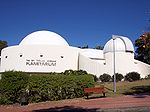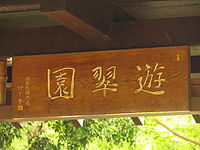
Brisbane Botanic Gardens, Mount Coot-tha
Encyclopedia

Brisbane
Brisbane is the capital and most populous city in the Australian state of Queensland and the third most populous city in Australia. Brisbane's metropolitan area has a population of over 2 million, and the South East Queensland urban conurbation, centred around Brisbane, encompasses a population of...
in Toowong
Toowong, Queensland
Toowong is an inner suburb of Brisbane, Australia which is located 5 km west of the Brisbane CBD. At the centre of Toowong is a commercial precinct including Toowong Village and several office buildings...
, Queensland
Queensland
Queensland is a state of Australia, occupying the north-eastern section of the mainland continent. It is bordered by the Northern Territory, South Australia and New South Wales to the west, south-west and south respectively. To the east, Queensland is bordered by the Coral Sea and Pacific Ocean...
, Australia
Australia
Australia , officially the Commonwealth of Australia, is a country in the Southern Hemisphere comprising the mainland of the Australian continent, the island of Tasmania, and numerous smaller islands in the Indian and Pacific Oceans. It is the world's sixth-largest country by total area...
, at the foot of Brisbane's tallest mountain, Mount Coot-tha.
History
The gardens, which were originally called the Mount Coot-tha Botanic Gardens and which cover 52 hectares, were established by the Brisbane City Council in 1970, and officially opened in 1976. The gardens are the second botanical gardens established in Brisbane. The original gardens, now known as the Brisbane City Botanic GardensBrisbane City Botanic Gardens
The City Botanic Gardens is located on a point known as Gardens Point on the Brisbane River adjacent to the central business district of the city of Brisbane...
are located in the Brisbane CBD
Brisbane central business district
The Brisbane central business district , sometimes referred to as the city, is a suburb of Brisbane, Queensland, Australia and is located on a point on the northern bank of the Brisbane River. The triangular shaped area is bounded by the Brisbane River to the east, south and west...
at Gardens Point
Gardens Point, Brisbane
Gardens Point is a point on the northern bank of the Brisbane River. The Brisbane CBD extends northwards of the point.Located here are Queensland's Parliament House, the Gardens Point campus of the Queensland University of Technology, the Brisbane City Botanic Gardens and Queensland's Old...
. The new gardens were developed by the City Council because the original city site could not be expanded and was flood prone.
Features
Features of the Brisbane Botanic Gardens include:- Tropical Display Dome—opened in December 1977, 28 m in diameter and 9 m high
- Japanese Garden
- Bonsai House
- Fern House
- Arid Zone and Cactus House
- Exotic Rainforest
- Australian Rainforest
- Fragant Plant and Herb Garden
- Temperate Garden
- Lagoon and Bamboo Grove
- Australian Plant communities
- National Freedom Wall
The gardens are open every day of the year from 8am to 5pm. Entry to the gardens is free.

Sir Thomas Brisbane Planetarium
Located adjacent to the entrance of the gardens is the Sir Thomas Brisbane PlanetariumSir Thomas Brisbane Planetarium
The Sir Thomas Brisbane Planetarium is a planetarium located on the grounds of Brisbane Botanic Gardens in the suburb of Toowong, Brisbane, Queensland, Australia...
, which incorporates the Cosmic Skydome. Sir Thomas Brisbane, in addition to being the Governor of New South Wales
Governors of New South Wales
The Governor of New South Wales is the state viceregal representative of the Australian monarch, Queen Elizabeth II, who is equally shared with 15 other sovereign nations in a form of personal union, as well as with the eleven other jurisdictions of Australia, and resides predominantly in her...
after whom the city of Brisbane was named, was also a renowned astronomer
Astronomer
An astronomer is a scientist who studies celestial bodies such as planets, stars and galaxies.Historically, astronomy was more concerned with the classification and description of phenomena in the sky, while astrophysics attempted to explain these phenomena and the differences between them using...
who catalogued the southern skies of Australia during his term.
Japanese Garden


Japanese garden
, that is, gardens in traditional Japanese style, can be found at private homes, in neighborhood or city parks, and at historical landmarks such as Buddhist temples, Shinto shrines and old castles....
design concepts, and uses Australian trees, native shrubs and flowers.
The Japan Pond and Garden was re-located from the Japanese Government Pavilion at Brisbane's World Expo '88
Expo '88
World Expo 88, also known as Expo '88, was a World's Fair held in Brisbane, the state capital of Queensland, Australia, during a six-month period between Saturday, 30 April 1988 and Sunday, 30 October 1988...
, and was opened after the conclusion of the Expo on February 6, 1989 through the work of the Brisbane Lord Mayor Sallyanne Atkinson and Nichahiro Hanamura, the chair of the Japan Association for the Expo. A commemorative dedication plaque from Brisbane City Council and the Japan Association for the 1988 Leisure Exposition and a welcome gate with calligraphy on a dedication tablet above the gate by then Prime Minister of Japan
Prime Minister of Japan
The is the head of government of Japan. He is appointed by the Emperor of Japan after being designated by the Diet from among its members, and must enjoy the confidence of the House of Representatives to remain in office...
Noboru Takeshita
Noboru Takeshita
was a Japanese politician and the 74th Prime Minister of Japan from November 6, 1987 to June 3, 1989.Takeshita was also the last Prime Minister during the long rule of the Emperor Shōwa.-Early years:...
greets visitors to the Garden at the entrance to the Garden. The Japanese calligraphy is engraved in gold, dedicating the name of the garden 'yu-tsui-en’. This literally translates to ‘enjoy, blue-green, garden’ and simply means ‘Come in to this garden and enjoy the blue of the water and green of the trees’.
The theme of the garden ‘tsuki-yama-chisen’ or ‘mountain-pond-stream’ is reflected in the water feature of the garden. Another feature which is not to be forgotten is just as special as the previous; the stone ‘tsukabai’ or water bowl. It is more than 100 years old and is used to ‘provide running water needed in the purification ritual that occurs before the tea ceremony
Tea ceremony
A tea ceremony is a ritualised form of making tea. The term generally refers to either chayi Chinese tea ceremony, chado Japanese tea ceremony, tarye Korean tea ceremony. The Japanese tea ceremony is more well known, and was influenced by the Chinese tea ceremony during ancient and medieval times....
’. The most captivating feature of the garden is the stones which create the mountain. These stones of the waterfall suggest ‘endurance and the eternal passing of time’.
In 2005 a clump of bamboo flowered just outside the gates to the Japanese Garden. Bamboo flowering is very rare and many bamboo enthusiasts go their whole lives without ever witnessing such an event. As is often the case after bamboo flowers, this plant died and was replaced with another specimen.
An annual Japan Cultural Festival is held at the Garden in September, featuring Japanese tea ceremony
Japanese tea ceremony
The Japanese tea ceremony, also called the Way of Tea, is a Japanese cultural activity involving the ceremonial preparation and presentation of matcha, powdered green tea. In Japanese, it is called . The manner in which it is performed, or the art of its performance, is called...
, Japanese calligraphy
Japanese calligraphy
is a form of calligraphy, or artistic writing, of the Japanese language. For a long time, the most esteemed calligrapher in Japan had been Wang Xizhi, a Chinese calligrapher in the 4th century but after the invention of Hiragana and Katakana, the Japanese unique syllabaries, the distinctive...
and ikebana
Ikebana
is the Japanese art of flower arrangement, also known as .-Etymology:"Ikebana" is from the Japanese and . Possible translations include "giving life to flowers" and "arranging flowers".- Approach :...
flower displays.

External links
- Brisbane Botanic Gardens Mount Coot-tha
- Wildlife, Parks and Gardens
- Brisbane parks and gardens
- Sir Thomas Brisbane Planetarium - Sir Thomas Brisbane Planetarium
- Brisbane's botanical gardens

